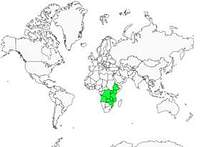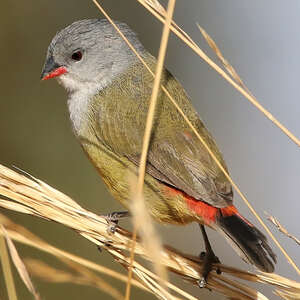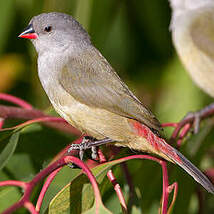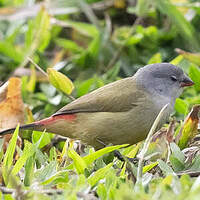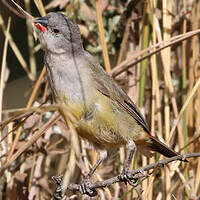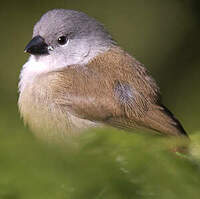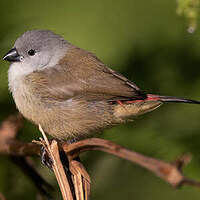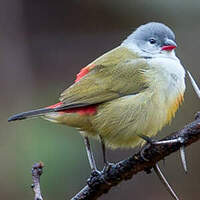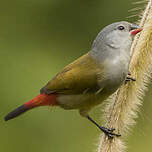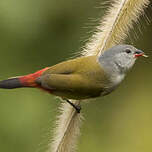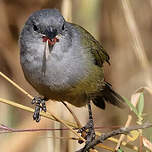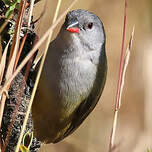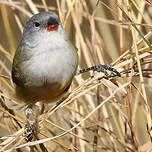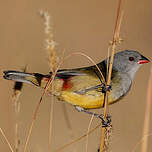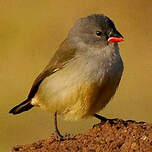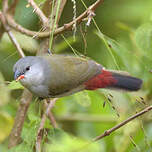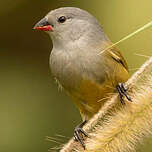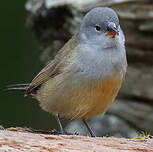Yellow-bellied Waxbill
Coccopygia quartinia - Astrild à ventre jaune
Identification
The Yellow-bellied Waxbill does not show any real sexual dimorphism, just a difference in the intensity of colors between the two sexes, with the female being a bit duller in plumage. The adult has a medium gray head, neck, and chest, a bit darker on the top of the head and paler on the throat. The upper parts (mantle, back, and wings) are olive green. The rump and the uppertail coverts are bright red. The tail, slightly rounded at the end, is black. The underside of the body (belly and cloacal area) is a lighter and yellower olive green than the back. The undertail coverts are yellow. The short and conical beak is bicolored with a black upper mandible and a carmine red lower mandible. The eye is dark red to dark brown with a gray orbital circle. The legs are black.
The juvenile resembles the female, but with the green parts of the latter clearly brown, the red of the rump less bright, and the beak completely black.
The three described subspecies differ only in the intensity of the gray and green of the adult plumage.
Subspecific information 3 subspecies
- Coccopygia quartinia quartinia (Eritrea, Ethiopia and se Sudan)
- Coccopygia quartinia kilimensis (e DRCongo to c Kenya and n Tanzania)
- Coccopygia quartinia stuartirwini (e Zambia to e Tanzania and e Zimbabwe)
Foreign names
- Astrild à ventre jaune,
- Estrilda ventrigualda oriental,
- bico-de-lacre-de-barriga-amarela,
- Gelbbauchastrild,
- Geelbuikastrild,
- Estrilda panciagialla,
- grönryggig astrild,
- Gulbukastrild,
- astrilda žltobruchá,
- astrild čtyřbarvý,
- Grønrygget Astrild,
- oliivivahanokka,
- Tropiese Swie (Tropiese Swiesysie),
- estrilda de ventre groc,
- szarogłówka żółtobrzucha,
- Желтобрюхий астрильд,
- ヒガシキバラカエデチョウ,
- 黄腹梅花雀,
- grönryggig astrild,
- 黃腹梅花雀,
Voice song and call
The usual call is a high-pitched psii or tsii, often repeated. When emitted in flight, it is not unlike the call of a Tree Pipit. The song has the same penetrating tone but is longer, tiiiiiiiiiit, tuuuuiiit or spui-sit-tu-si-li. The variations observed seem to be related to the level of excitement of the individual Yellow-bellied Waxbills.
Habitat
The Yellow-bellied Waxbill frequents rocky hills, small clearings and forest edges. The inhabited forests are mountainous, open to semi open, with diverse vegetative strata, generally close to water, sometimes even on the edges of crops or in large gardens.
Behaviour character trait
Dietfeeding habits
Reproduction nesting
The Yellow-bellied Waxbill breeds in isolated pairs or small flocks, never in large groups or with other species.
Reproduction occurs throughout the year, the season varying according to the local rainfall. To seduce the female, the male skips on the ground near her, standing upright with its beak tilted downwards and the feathers of its flanks and belly puffed up. He warbles and emits a soft and quick song. The copulation will not take place before the male has seduced the female.The nest is a thin and closed structure with a lateral entrance, roughly covered with fine vegetation. The entrance is lined with fine grass. It is built between 1 and 5 metres off the ground in a densely-foliaged shrub or small tree. It is often found in a mistletoe tuft and sometimes even near a wasps' nest. The female lays 3-6 white eggs that she incubates for 13-14 days. The parents feed the young for 21-22 days.
The species can be parasitized by the Common Widowbird which adds its also white eggs to those of the waxbill.
Geographic range
The Yellow-bellied Waxbill is a bird found in East and Southeast Africa. It is found discontinuously from Ethiopia in the north to Mozambique in the south and from the Indian Ocean in the east to the Albertine Rift in the west. It is not a migratory bird and the only significant movements are seasonal movements such as in Zimbabwe where the birds from the highland descend during the bad season.
Threats - protection
Sources of information
- IOC World Bird List (v15.1), Gill, F and D Donsker (Eds). 2025-12-07.
- Sparrows and Buntings, BYers Clive
- Birds of the Horn of Africa, Nigel Redman
- HBW Alive,
Other sources of interest
 Specification sheet created on
21/07/2023 by Nathalie Santa Maria
Specification sheet created on
21/07/2023 by Nathalie Santa MariaTranslation by AI Oiseaux.net
© 1996-2025 Oiseaux.net
- Accipitriformes
- Aegotheliformes
- Anseriformes
- Apodiformes
- Apterygiformes
- Bucerotiformes
- Caprimulgiformes
- Cariamiformes
- Casuariiformes
- Charadriiformes
- Ciconiiformes
- Coliiformes
- Columbiformes
- Coraciiformes
- Cuculiformes
- Eurypygiformes
- Falconiformes
- Galliformes
- Gaviiformes
- Gruiformes
- Leptosomiformes
- Mesitornithiformes
- Musophagiformes
- Nyctibiiformes
- Opisthocomiformes
- Otidiformes
- Passeriformes
- Pelecaniformes
- Phaethontiformes
- Phoenicopteriformes
- Piciformes
- Podargiformes
- Podicipediformes
- Procellariiformes
- Psittaciformes
- Pterocliformes
- Rheiformes
- Sphenisciformes
- Steatornithiformes
- Strigiformes
- Struthioniformes
- Suliformes
- Tinamiformes
- Trogoniformes


